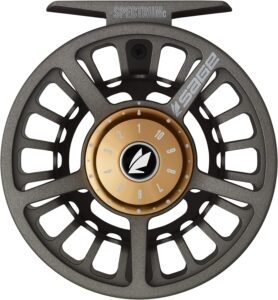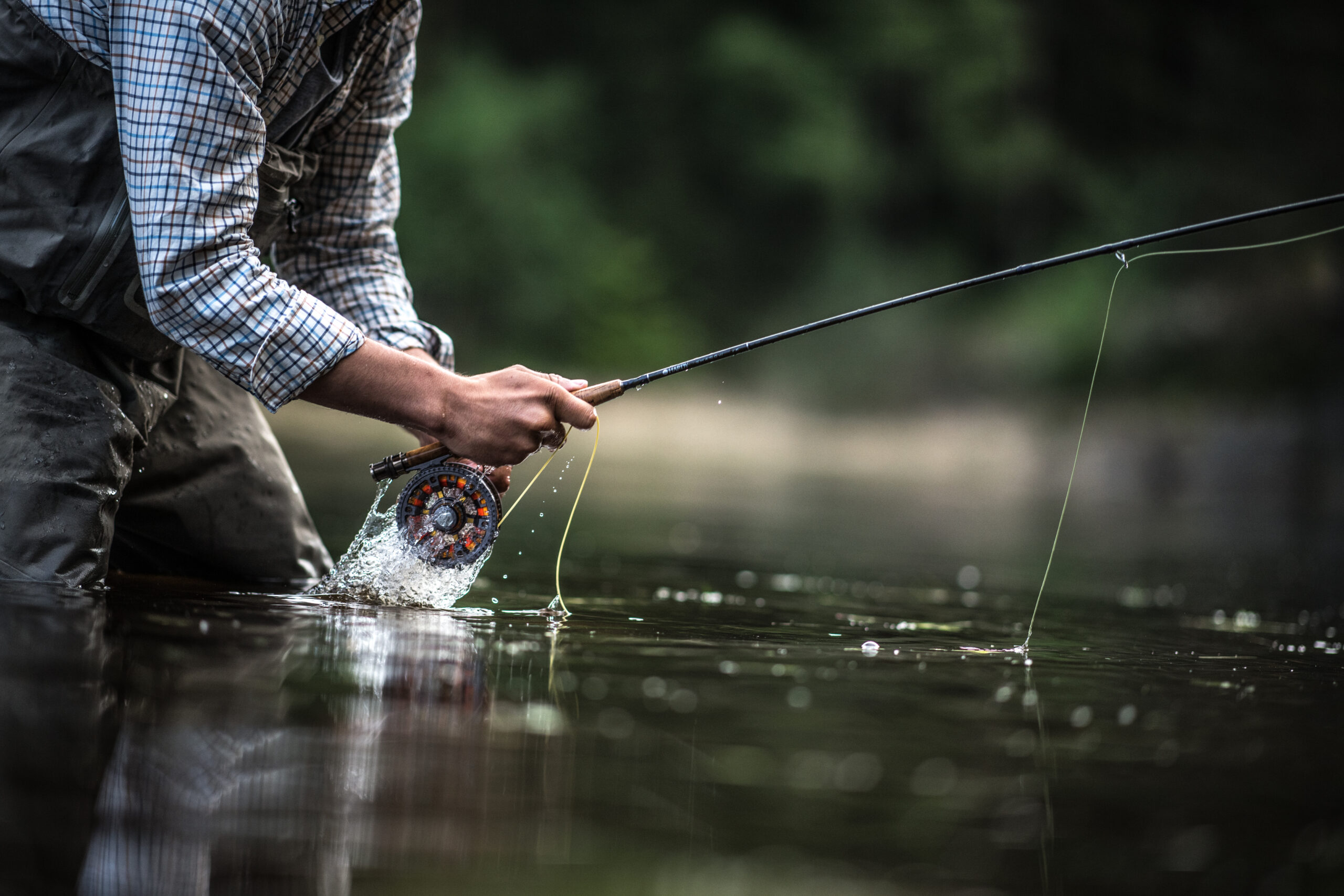Fly Fishing Reel
What is a Fly Fishing Reel
A fly fishing reel is a specialized type explicitly designed for fly fishing.
Unlike conventional fishing reels, which are used to cast and retrieve heavier lures and baits, fly fishing reels are crafted to handle the unique demands of casting lightweight fly lures.
These reels are crucial in storing fly lines and backing, providing smooth and efficient line management during casting, retrieving, and fighting fish.
Fly fishing reels are characterized by their simple yet precise mechanics.
They typically feature a drag system that allows anglers to adjust the resistance a hooked fish feels, helping to prevent the line from breaking during a fight.
The design of a fly reel is such that it balances the fly rod during casting, enhancing the overall fishing experience.
Various fly reels are designed for specific fishing conditions and species.
These include single-action reels, which are the most common and have a direct drive; multiplier reels, which increase the retrieve rate; and automatic reels, which use a spring-loaded mechanism for line retrieval.
Fly fishing reels are functional and often considered art pieces, with some anglers collecting vintage or custom-designed reels.
Types Of Fishing Reels
Here are the main types of fishing reels:
1. Spincast Reels – Easy to use push button design, enclosed housing over the spool, ideal for beginners. Suitable for small to medium-sized fish.
2. Spinning Reels – Open-faced design with the fixed spool, bail wraps line for the cast, then flips to release. Great for casting light lures and baits. It is very versatile for all fish sizes. It’s a popular reel overall.
3. Baitcast Reels – Revolve around a rotating spool controlled by thumb, allowing accurate targeted casts. It is geared for heavier lines/lures. Take practice to master but sought-after for bass fishing tournaments.
4. Fly Reels – Designed for fly fishing, simple single-action drums store large amounts of line critical, giving running fish, while disc drags help play fish once hooked. Paired with fly rods throwing flies to mimic insects that trout and salmon feed on.
5. Conventional Reels – Large complex reels used for offshore big game fishing. Star or lever drag systems allow adjustable resistance to fight powerful bulldozing fish—high capacities needed for long runs taken on the line.
There are also variations on these, like underspin reels, offshore jigging, trolling reels, and surf reels, but these five represent the most popular formats anglers use depending on species and fishing situations. Many factors play into decisions – size, gear ratios, drag systems, and intended fishing methods.
Types Of Fishing Rods
Here are the main types of fishing rods:
1. Casting Rods – Best for casting light lures, jigs, and live bait. It is well-balanced with a good mix of power and flexibility. The go-to all-purpose freshwater rod is excellent for beginners.
2. Spinning Rods – Ideal for casting small lures and lightweight terminal tackle using a spinning reel. Supple tips provide sensitivity-detecting light bites but have backbone landing fish—extremely versatile rods.
3. Baitcasting Rods – The rod counterparts are designed to work with high-performance baitcasting reels and heavier lures. Stiffer rods project long, accurate casts; strong hooks are set out of dense structures with a backbone, bringing big fish out on lighter lines.
4. Spincasting Rods – All-inclusive, easy-to-use rod/reel combos for young anglers using push-button reels ideal for recreational catches. Affordable and durable.
5. Fly Fishing Rods – Supple flexible long rods cast thin, lightweight fly lines delivering flies or lures to fish; excellent engineering technology is required for optimum presentation. Specialized based on the size of fish targeted.
6. Surf Rods – Unique long rods 12-14 feet, throwing heavy lead weights and baits vast distances from beaches into the surf and beyond, and detecting bites with extreme sensitivity. Significant leverage against decisive catches.
7. Ice Fishing Rods – Short ultra light rods perfect for jigging vertically through lake ice or casting tiny lures finesse style, with extreme sensitivity telegraphing light bites.
Match the rod to species habits/size and preferred fishing methods, maximizing success; it makes a big difference in results!

Before You Begin: What You’ll Need
- Fly reel
- Fly rod
- Backing (typically 20-pound Dacron)
- Fly line
- Leader
- Tools: Nail knot tool (or something similar), scissors or line clippers
Step-by-Step Guide
- Attaching the Backing:
- The Arbor Knot:
- Make a loop around the reel’s spool (arbor) with the backing.
- Create an overhand knot around the standing part of the backing.
- Pass the loop end through the overhand knot again.
- Pull tight to cinch it down on the spool.
- Nail Knot:
- Using your nail knot tool (or even a pen), wrap the backing around the tool 5-6 times.
- Pass the tag end of the backing through the loops and the tool’s tip.
- Pull tight, slide the knot off the tool, and tighten onto the reel’s spool.
- The Arbor Knot:
- Loading the Fly Line:
- Winding Direction: Ensure you wind the fly line in the same direction it comes off the spool. This prevents unnecessary coiling and twisting.
- Apply Tension: Have a friend hold the fly line spool or use a pencil through the center to provide resistance as you wind it. This creates an even, snug fit on your reel.
- Leave Space: Don’t fill the reel to the brim – leave some space to accommodate the backing and leader.
- Connecting Backing and Fly Line:
- Loop-to-Loop: If your fly line has a welded loop, slip it over the loop of your backing and bring the reel through. Pull tight for a simple connection.
- Albright Knot: An Albright knot provides a secure connection without a welded loop. (Many online tutorials demonstrate this knot).
- Attaching the Leader:
- Loop-to-Loop: Many leaders come with a pre-tied loop for easy loop-to-loop connection with your fly line.
- Improved Clinch Knot: This can attach the leader directly to the fly line without using a loop.
- Tying on a Fly:
- Improved Clinch Knot: A versatile knot for directly attaching your chosen fly to the leader.
Additional Tips
- Check Your Reel’s Manual: Refer to your specific reel’s instructions for recommendations.
- Practice Makes Perfect: Setting up your reel takes practice at first. Don’t get discouraged.
- Seek Help: Most fly shops are happy to set up your reel for a small fee. Great if you’re also shopping for gear!
Here’s your breakdown of how to use a fly rod and reel. Keep in mind a hands-on lesson with an instructor is invaluable, but this overview will equip you with the foundational knowledge:
Casting
- Grip: Place your thumb on top of the cork grip towards the reel, like you’re giving a gentle “thumbs up.” Your other fingers loosely curl around the handle.
- Starting Position: Keep your elbow close to your side and the rod tip down towards the water. A good amount of fly line should be extended out the tip.
- The Backcast: Smoothly lift the rod tip in a controlled backward motion to about the vertical position (think noon on a clock face), and let the line straighten out behind you
- The Pause: Wait for the line to straighten out behind you. This loads the rod, allowing it to propel the line forward.
- The Forward Cast: Smoothly accelerate the rod forward, stopping abruptly around the 10 o’clock position. This transfers the energy into the line.
- The Shoot: Once the fly line starts unfurling in the air, release a bit of extra line from your line hand for greater distance.
- Presentation: Aim to “lay” the fly gently on the water as if a natural insect were landing.
Retrieving the Line
- Simple Stripping: The primary method of retrieving lines. Use your free hand to pull the line in short strips. This gives life to the fly and simulates insect movement.
- Reeling: The reel comes into play more when fighting a fish, but you can also reel in to pick up slack lines after casts.
Fishing with a Fly
- Reading the Water: Fish tend to hold in locations that provide food and shelter. Learn to spot current seams, eddies, drop-offs, and underwater structures. These spots are more likely to be productive.
- Fly Selection: Choosing a fly that imitates the insects fish are naturally feeding on increases your chances of success. Observe your surroundings and research to match the hatch’ of insects prevalent at the time.
- Presentation: How you present your fly matters! Aim to mimic the movement of natural insects to fool discerning fish.
Essential Techniques
- Roll Cast: Useful for limited backcast space, when obstacles are behind you, or to pick up a sunk line.
- Mending: This helps control the drift of your fly by “mending” the line during the cast to get a natural, drag-free presentation.
- Setting the Hook: Don’t pull up violently when a fish takes. Lift the rod tip firmly or sharply strip the line back to secure the hook in the fish’s mouth.
Additional Tips
- Take Lessons: A qualified instructor can save you a lot of frustration and get you casting properly quicker.
- Watch Videos: YouTube has countless excellent tutorials by experts. See the fly-casting process visually!
- Practice, Practice, Practice: Like any skill, fly fishing takes time to master.
Sage Spectrum C Fly Fishing Reel with Rio Backing:
A Comprehensive Review
In fly fishing, having the right gear can make all the difference between a good day on the water and a great one.
The Sage Spectrum C Fly Fishing Reel, complete with Rio Backing, is a product that stands out for its quality, performance, and value.
As an avid angler, I’ve had the pleasure of testing this reel in various fishing conditions, and here’s my comprehensive review.
Build Quality and Design:
The Sage Spectrum C Fly Fishing Reel boasts a robust construction, featuring a die-cast frame that perfectly balances durability and lightweight design.The aesthetic is sleek and modern, with an excellent finish against the elements.
The large arbor design is a significant plus, allowing for quick line retrieval and reducing line memory, which is crucial during long days on the water.
Performance
Performance-wise, the Sage Spectrum C excels.
The sealed carbon drag system is smooth and powerful, offering consistent performance whether battling small stream trout or larger river specimens.
Adjusting the drag is intuitive and precise, allowing for quick changes on the fly without any fuss.
Including Rio Backing is thoughtful, ensuring anglers have high-quality backing right out of the box.
Rio’s reputation for durability and strength complements Spectrum C’s capabilities, making for a winning combination that’s ready for action.
Usability:
One of the reel’s standout features is its ease of use. Whether you’re a seasoned angler or new to fly fishing, the Spectrum C is user-friendly. Switching between left and right-hand retrieve is straightforward,
accommodating all anglers. The ergonomic handle is comfortable for all-day use, reducing fatigue during those long sessions on the water.
Value:
Regarding value, the Sage Spectrum C Fly Fishing Reel with Rio Backing is hard to beat. For its price point, it offers features and performance typically found in higher-priced reels.
It’s an excellent investment for anglers of all levels, providing reliability, quality, and a fantastic fishing experience without breaking the bank.
Final Thoughts:
The Sage Spectrum C Fly Fishing Reel, paired with Rio Backing, combines quality, performance, and value in one package.
It’s suitable for various fishing conditions and species, making it a versatile addition to any angler’s arsenal.
Whether you’re chasing trout in small streams or targeting larger fish in rivers and lakes, the Spectrum C is up to the task.
Its durability means it’s a reel you can rely on for many seasons.
If you’re in the market for a new fly fishing reel, the Sage Spectrum C with Rio Backing should be on your radar.
